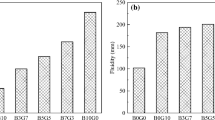Abstract
Magnesium and potassium phosphate cement (MKPC) sample were prepared by mixing dead burnt MgO powder, potassium phosphate and different dosages of retarder borax to investigate the effect of borax on its hydration and hardening characteristics. The pH value, fluidity, hydration temperature and strength development of MKPC paste were investigated, and the mineralogical composition and microstructural morphology of its hydration products were analyzed. The experimental results indicated that, within a certain dosage, borax caused an endothermal effect for MKPC paste, which decreased the early hydration rate of MKPC paste, increased the fluidity of MKPC paste. Thus, strength and micro-morphology of hardened MKPC are affected. It can be concluded that borax in MKPC paste retards the early hydration rate of MKPC paste by forming a film onto surface of MgO, decreasing the temperature and increasing the pH value of the system. As borax dosage varying, different factors may dorminate the effects.
Similar content being viewed by others
References
B E I Abdelrazig, J H Sharp, B El-Jazairi. The Chemical Composition of Mortars Made from Magnesia-Phosphate Cement[J]. Cem. Concr. Res., 1988, 18(3): 415–425
Q Yang, X Wu. Factors Influencing Properties of Phosphate Cement-based Binder for Rapid Repair of Concrete[J]. Cem. Concr. Res., 1999, 29(3): 389–396
Q. Yang, B. Zhu and X. Wu, Characteristics and Durability test of Magnesium Phosphate Cement-based Material for Rapid Repair of Concrete[J]. Materials and Structures, 2000, 33(4): 229–234
Q Yang, S Zhang, X Wu. Deicer-scaling Resistance of Phosphate Cement-based Binder for Rapid Repair of Concrete[ J]. Cem. Concr. Res., 2002, 32(1): 165–168
S S Seehra, Saroj Gupta, Satander Kumar. Rapid Setting Magnesium Phosphate Cement for Quick Repair of Concrete Pavements-Characterisation and Durability Aspects[J]. Cem. Concr. Res., 1993, 23(2): 254–266
H Jiang, B Liang, L M Zhang. Investigation of MPB with Super Early Strength for Repair of Concrete[J]. Journal of Building Materials, 2001, 4(2): 196–198 (in Chinese)
H Jiang, L M Zhang. Study on Magnesium Phosphate Cement[J]. Wuhan Gongye Daxue Xuebao, 2001, 23(4): 32–34 (in Chinese)
A Wagh, SY Jeong, D Singh. High Strength Phosphate Cement Using Industrial by Product Ashes[C]. Proceedings of First International Conference. In: A Azizinannini et al., eds..Amer. Soc. Civil Eng., 1997: 542–533
A Wagh, S Y Jeong, D Singh. Method of Waste Stabilization via Chemically Bonded Phosphate Ceramics[P]. U S Patent, 5830815, 1998-11-3
D Singh, A Wagh, Phosphate Bonded Structural Product from High Volume Wastes[P]. US Patent, 5846894. 1998-12-8
Zhu Ding, Zongjin Li. High Early Strength Phosphate Cement with Fly Ash[J]. ACI Material Journal, 2005, 102(6): 375–381
Zhu Ding, Zongjin Li.The Preparation and Properties of High Early Strength Magnesium Phosphosilicate Cement[J]. Chinese Journal of Materials Research, 2006, 20(2): 141–147 (in Chinese)
E Soudée, J Péra. Mechanism of Setting Reaction in Magnesia-Phosphate Cements[J]. Cem. Concr. Res., 2000, 30: 315–321
E Soudée, J Péra. Influence of Magnesia Surface on the Setting Time of Magnesia-Phosphate Cement[J]. Cem. Concr. Res., 2002, 32: 153–157
T Sugama, L E Kukacka. Magnesium Monophosphate Cement Derived from Diammonium Phosphate Solutions[J]. Cem. Concr. Res., 1983, 13(3): 407–416
T Sugama, L E Kukacka. Characteristics of Magnesium Polyphosphate Cements Derived from Ammonium Polyphosphate Solutions[J]. Cem. Concr. Res., 1983, 13: 499–506
BEI Abdelrazig, JH Sharp, B El-Jazairi. The Microstructure and Mechanical Properties of Mortars Made from Magnesia-Phosphate Cement[J]. Cem. Concr. Res., 1989, 19: 247–258
Sarkar AK. Phosphate Cement Based Fast Setting Binders[J]. Ceram. Bulletin, 1990, 69(2): 234–238
Sarkar AK. Hydration and Dehydration Characteristics of Struvite and Dittmarite Pertaining to Magnesium Ammonuim Phosphate Cement Systems[J]. Ceram. Bulletin, 1990, 69(2): 234–238
C S Liu, F Y Cheng, Y H, et al. Effect of the Particle Sizes of Raw Materials on Hydration and Harden Process of Calcium Phosphate Bone Cement[J]. Journal of Chinese Ceramic Society, 1999, 27(2): 139–146(in Chinese)
Author information
Authors and Affiliations
Corresponding author
Rights and permissions
About this article
Cite this article
Yang, J., Qian, C. Effect of borax on hydration and hardening properties of magnesium and pottassium phosphate cement pastes. J. Wuhan Univ. Technol.-Mat. Sci. Edit. 25, 613–618 (2010). https://doi.org/10.1007/s11595-010-0055-6
Received:
Accepted:
Published:
Issue Date:
DOI: https://doi.org/10.1007/s11595-010-0055-6




